Taxonomy: Class: Mammalia; Order: Artiodactyla; Family: Cervidae
Description
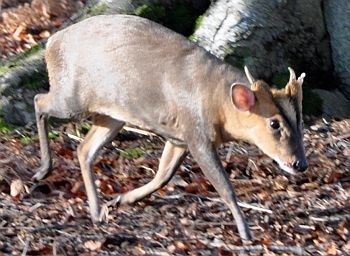
Muntjac © Peter Thompson
The muntjac originates from south-east China and Taiwan, It is a small brown deer with a white underside, no more than 50 cm tall at the shoulder. A characteristic pose is head held lower than the back. It was originally introduced to Woburn Park, Bedfordshire, in 1894. Further releases and escapes have resulted in the species becoming established in the wild since the 1930s. The muntjac likes woodland habitats with a dense understorey, and breeds throughout the year. It can cause serious damage to gardens, coppice woodland and sometimes forestry. The muntjac (both sexes) may be shot all year round.
Further information:
Mammal Society website muntjac page.
Conservation status and legislation
Status:
UK: Non-native
World: Least Concern (IUCN Red List)
Legislation:
Distribution and abundance
The muntjac is present throughout most of southern and eastern England, and is penetrating into Wales. There are scattered records from northern England and a few from Scotland. It is absent from Ireland.
Estimates of muntjac abundance (numbers of individuals in the spring) across the UK, from Harris et al. (1995):
Recent trends from the National Gamebag Census
United Kingdom
Index of bag density from 1980 to 2009 (see statistical methods and interpretational considerations).
Error bars represent 95% confidence intervals.
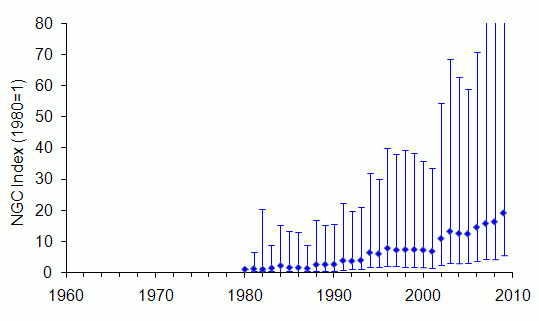
There has been a rapid increase in the bag index between 1980 and 2009, with average gains of 12% per annum across the period. The increase continued at a similar rate between 1995 and 2009. This reflects the ongoing range expansion and increasing abundance of this introduced species (see maps).
Change in muntjac bags over time, with 95% confidence limits (see statistical methods):
| Country |
Sites |
Start
year |
End
year |
Change (%)
1961-2009 |
Change (%)
1984-2009 |
Change (%)
1995-2009 |
| United Kingdom |
176 |
1980 |
2009 |
1756*
387 to 4491 |
1148*
429 to 2904 |
210*
138 to 337 |
* significant at P < 0.05
England
Index of bag density from 1980 to 2009 (see statistical methods and interpretational considerations).
Error bars represent 95% confidence intervals.
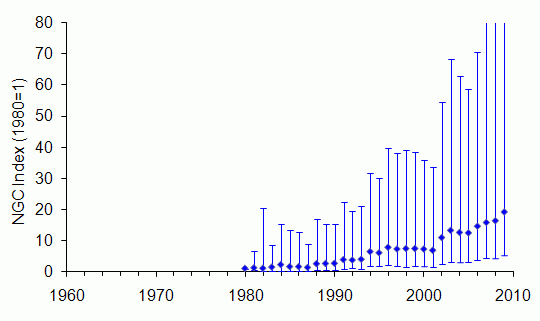
There has been a rapid increase in the bag index between 1980 and 2009, with average gains of 12% per annum across the period. The increase continued at a similar rate between 1995 and 2009. Regionally, the majority of records were from the easterly lowlands, reflecting the source of the ongoing range expansion and increasing abundance of this introduced species (see maps).
Change in muntjac bags over time, with 95% confidence limits (see statistical methods):
| Country |
Sites |
Start
year |
End
year |
Change (%)
1961-2009 |
Change (%)
1984-2009 |
Change (%)
1995-2009 |
| England |
176 |
1980 |
2009 |
1760*
387 to 4491 |
1148*
429 to 2904 |
210*
138 to 337 |
* significant at P < 0.05
Scotland
There are too few bag records of muntjac to produce an index graph. 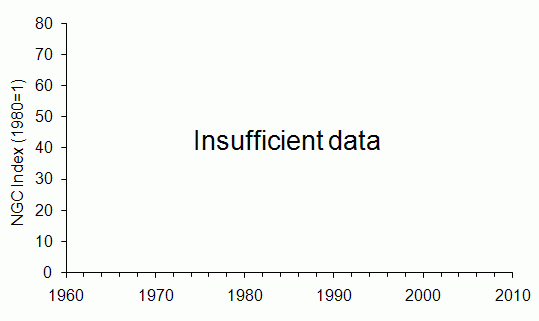
There are too few bag records of muntjac to evaluate rates of change over time
| Country |
Sites |
Start
year |
End
year |
Change (%)
1961-2009 |
Change (%)
1984-2009 |
Change (%)
1995-2009 |
| Scotland |
Too few sites |
Wales
There are too few bag records of muntjac to produce an index graph. 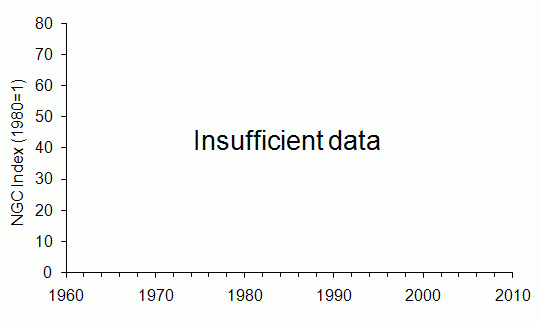
There are too few bag records of muntjac to evaluate rates of change over time
| Country |
Sites |
Start
year |
End
year |
Change (%)
1961-2009 |
Change (%)
1984-2009 |
Change (%)
1995-2009 |
| Wales |
Too few sites |
N Ireland
There are too few bag records of muntjac to produce an index graph. 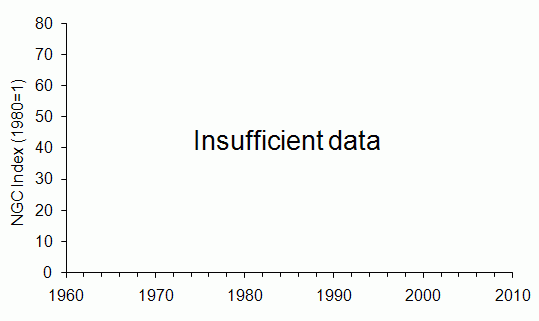
There are too few bag records of muntjac to evaluate rates of change over time
| Country |
Sites |
Start
year |
End
year |
Change (%)
1961-2009 |
Change (%)
1984-2009 |
Change (%)
1995-2009 |
| N Ireland |
Too few sites |
Environmental zones
Change in muntjac bags over time, with 95% confidence limits (see statistical methods):
| Environmental zone |
Sites |
Start
year |
End
year |
Change (%)
1961-2009 |
Change (%)
1984-2009 |
Change (%)
1995-2009 |
| Easterly lowlands (England/Wales) |
158 |
1980 |
2009 |
1760*
341 to 4692 |
1150*
388 to 3183 |
209*
138 to 326 |
| Westerly lowlands (England/Wales) |
Too few sites |
| Uplands (England/Wales) |
Too few sites |
| Lowlands (Scotland) |
Too few sites |
| Intermediate uplands/islands (Scotland) |
Too few sites |
| True uplands (Scotland) |
Too few sites |
* significant at P < 0.05
Comparison with BBS mammal data
Since 1995, data on muntjac abundance have been collected under the Breeding Bird Survey (BBS) organised by the British Trust for Ornithology. Below, the UK trend from the NGC is compared to the one from the BBS (from 1995 onwards).
NGC index of bag density (blue) and BBS index of abundance (red), from 1995 to 2009.
Error bars represent 95% confidence intervals.
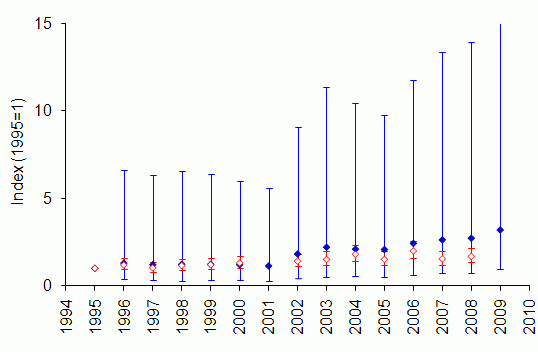
Like the NGC, the BBS has shown a significant increase since 1995. For all years, the BBS confidence intervals are completely within the NGC confidence intervals, suggesting that both series agree.
Long-term trend from the National Gamebag Census
There are too few bag records of muntjac to produce a trend starting before 1980.
References and further reading
- Battersby,J. (2005). UK Mammals: Species Status and Population Trends. Joint Nature Conservation Committee/Tracking Mammals Partnership, Peterborough (JNCC download page).
- Chapman,N.G., Harris,S. & Stanford,A. (1994). Reeves' muntjac Muntiacus reevesii in Britain: their history, spread, habitat selection, and the role of human intervention in accelerating their dispersal. Mammal Review 24: 113-160.
- Chapman,N.G. & Harris,S. (1996). Muntjac. Mammal Society & British Deer Society, Southampton & Fordingbridge.
- Deer Initiative (2008). Species Ecology: Muntjac Deer. England & Wales Best Practice Guides, The Deer Initiative, Chirk (PDF file - 4,638 KB).
- Harris,S., Morris,P., Wray,S. & Yalden,D.W. (1995). A Review of British Mammals: Population Estimates and Conservation Status of British Mammals Other than Cetaceans. Joint Nature Conservation Committee, Peterborough (JNCC download page).
- Harris,S. & Yalden,D.W. (2008). Mammals of the British Isles: Handbook, 4th edition. Mammal Society, Southampton.
This report should be cited as: Aebischer,N.J., Davey,P.D. & Kingdon,N.G. (2011). National Gamebag Census: Mammal Trends to 2009. Game & Wildlife Conservation Trust, Fordingbridge (http://www.gwct.org.uk/ngcmammals).
Return to species list